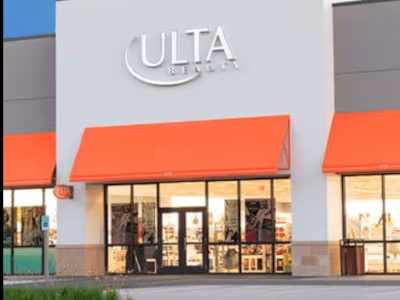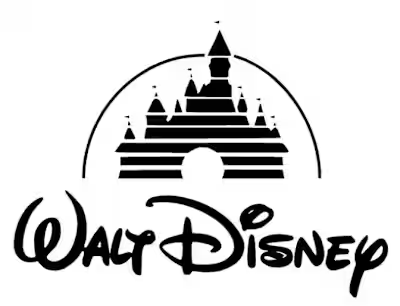International Market Research: Kwik-E-Mart
The research was conducted to study international markets in Norway and as a fictional owner of Kwik-E-Mart, a grocery store, I studied the market to develop a recommendation based on market research, threats, and opportunities. My recommendation states whether the business should operate and expand its operations in Norway.
Recommendation
I do not recommend Kwik-E-Mart to open its foreign stores in Norway because investment opportunities for foreigners within the food retail sector are limited. Norway is a very urban based and rural country where expenditures tend to be costly. The country is experiencing a high volume of unemployment, causing employees to spend money on cheaper substitutes and rely heavily on the food received through non-profit organizations. Investment opportunities are fewer in sectors of alcohol. Based on first hand experience, when I traveled to Europe, the majority of the groceries offered alcoholic beverages. Many customers are used to the thought that a grocery store should include alcoholic beverages for purchase. As Kwik-E-Mart expands its operations to Norway, it may experience restrictions on selling of items and in acquiring long term leases for the grocery stores. Norwegians would prefer purchasing their items from local and known grocery stores and it may take several years for a foreign grocery store to become profitable within the country.
Norwegians have already provided relaxed and advanced online shopping methods to its residents, making them to be at their top position in grocery retail business. Moreover, Norway is a country that is based on oil, gas, transportation, and technological advancement, meaning their economy would be based heavily on oil prices. Investors do not have tax benefits in Norway. I personally do not recommend opening a grocery store in Norway because the three major grocery outlets have established conceptual categories, creating small grocery stores in every region of Norway. The grocery retail market is strongly in control by the Norwegian companies and they already have customers that trust their business and that shop from them on a daily basis. Since Norway has a positive current balance of payments, it may be a good idea for Norwegians to use the surplus on advancing their grocery facilities like offering scanned trolleys as checkout counters, in which customers would pay through their trolley and leave the store immediately.
Executive Summary
Norway is part of Northern Europe and is popular for its two large cities, Oslo and Bergen. Oslo is the city where the majority of trading occurs. Norway is not registered as a member of the European Union, but due to its connection with the European Economic Area, the country is letting certain decisions to be based on those actions and activities that take place within the European Union. Norway is rich in natural resources like oil and natural gas. Because of its valuable resources, the country lets prices of normal goods to change based on oil prices and value across time. The COVID-19 pandemic has brought a huge volume of unemployment in Norway. The Norges Bank is the central bank of Norway. Two equity markets in Norway are Oslo exchange market and Oslo Axess. Norway’s major investors are from the Netherlands and Sweden. There are three major grocery retail markets in Norway. Those grocery outlets are NorgesGruppen, Coop, and ReitanGruppen. NorgesGruppen ranks the highest within the grocery retail market in Norway. Also, Norway is known as an isolated and rural country. Because of its rural structure, expenditures in areas of transportation, logistics, and telecommunications are very costly. Some restrictions apply to foreigners investing in Norway, including the idea that Norway does not offer high tax benefits to investors.
Country Overview
Demographic Data
Norway is a Scandinavian country in Northern Europe, which also shares its borders with Sweden, Finland, and Russia. The country also shares its borders with the Barents, Norwegian, North, and Skagerrak Seas. Moreover, about 80% of the population live in and around major cities, meaning Norway is a fairly urban country (“Norway Population 2021”). Also, two largest cities in Norway are Oslo and Bergen. Oslo is the capital and most populated city in Norway, with more than 580,000 people living within the city, not including the metropolitan area. The metropolitan area is known to have around a million residents. Oslo is the city where the majority of manufacturing, shipping, banking, and trading occurs. Additionally, Oslo is known as the second most expensive city after Tokyo, Japan. Some of the popular languages spoken in Norway include Bokmal Norwegian, Nynorsk Norwegian, and Finnish. About 71.5% of the people living in Norway are christian. Also, about 2.8% of the people in Norway are Roman Catholic and 2.9% of the population are Muslims (“Norway Population 2021”).
Furthermore, understanding the information about the population size, composition, and development helps in planning decisions and making policies for various societies in Norway. Norway has a relatively consistent population growth every year and there is a slightly negative statistic because a high percentage of the people are aged over 65 as shown in figure 1.1. Based on the latest United Nations data, it has been projected that the current population in Norway is 5,470,255 (“Norway Population 2021”). An increase in the number of immigration has also increased the population size. Moreover, the birth rate in Norway is lower than the worldwide average, meaning average Norwegian women give birth to 1.72 children yearly. The change in population is not dependent on this factor alone. Instead, the number of immigrants entering Norway has kept the numbers increasing or constant. For example, since 2019, the growth rate in Norway has been 0.89%, meaning 50,000 people are added to the population each year (“Norway Population 2021”). According to data published by the Population Reference Bureau, Norway’s population size will increase by 11% more than it was in 2004, making it to reach 5.1 million people in 2025 (“Demographic Panorama - Norway” 7).
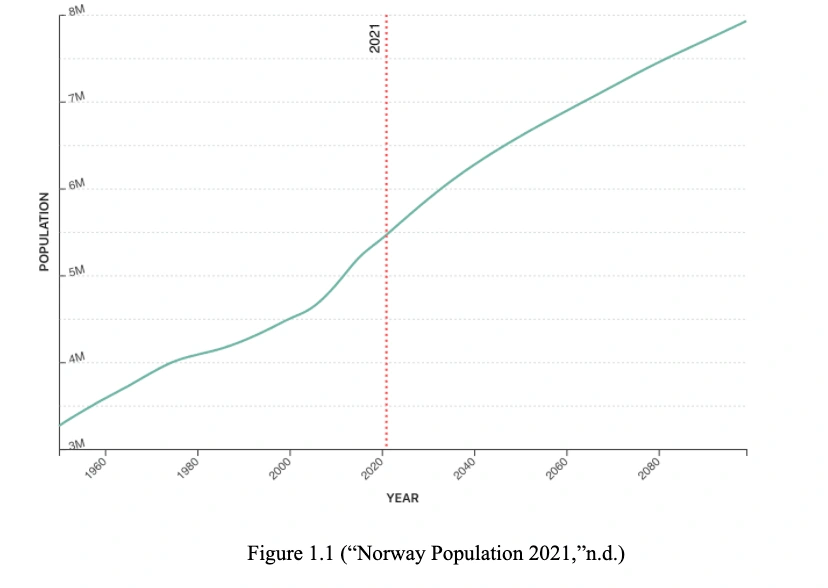
Political Organization
Norway is a constitutional monarchy that divides its power between the parliament, the cabinet, and the supreme court. In 1814, when the country signed the constitution, it achieved a great milestone for modern Norway and opened many opportunities for people (“Government & Politics”). Norway is not a member of the European Union, however, through its connection with the European Economic Area, Norway became closely linked to the actions and activities of the European Union (“Government & Politics”). In other words, Norway is part of the European Economic Area and a member of the North Atlantic Treaty Organization. Moreover, King Harald V, King of Norway and head of state, has no real power, instead, the parliament, Stortinget, has the real authority to exercise power (Jansson).
The constitution grants executive powers to the King but those powers are exercised by the cabinet (“The Political Framework of Norway”). The King only has a ceremonial role with some reserved powers. The parliament consists of 169 members. Norway has a union government that is composed of several parties. Currently, eight parties are represented in the parliament (“The Political Framework of Norway”). The eight parties are Norwegian Labour Party, Progress Party, Conservative Party, Liberal Party, Christian Democratic Party, Socialist Left Party, Centre Party, and The Green Party (“The Political Framework of Norway”). The Labour Party and the Conservative Party are the most represented in the parliament.
Recent History
In 1972, the Norwegian government had negotiated a trade agreement with European Union so that Norwegian companies could have access to European markets. The politicians and the public had implemented ways of improving Norway’s economic development. They paid close attention to Norway’s comparative advantage by specializing in certain areas of exports, leading to a great effect on Norway’s agricultural policy. Also, in 2019, Norway’s trade in goods with the European Union brought a deficit of 2.5 billion Euros. Moreover, in April 2020, the Norwegian government had decided to cut oil production to help stabilize and control the global oil market. The government waited and noticed that oil output was increasing in November 2020 while gas production was declining. The Norwegian petroleum directorate announced that without new oil and gas productions, Norway’s energy production would decline rapidly after 2030 (“The Political Framework of Norway”).
During the period March to April 2020, retail sales had increased by 4.8% due to actions that were taken against the spread of the coronavirus like travel restrictions and closure of cultural and sporting events. This strong growth in retail sales shows that Norwegians have changed their preferences and consumption patterns in a way that they started to spend less on services and more on certain retail goods (“Strong Increase in Retail Sales in April”). The largest contribution to the growth in the retail sector was in stores selling building materials and stores selling sporting equipment and boats (“Strong Increase in Retail Sales in April”). Other retail sectors that experienced growth were clothing stores, e-commerce, flower shops, and furniture shops. On the other hand, gas stations and pharmacies experienced a decrease in sales (“Strong Increase in Retail Sales in April”).
Macro Fundamentals
Monetary and Fiscal Policy
Norway has a monetary policy regime that serves as a system of neither a fixed exchange rate nor an inflation target (“Svein Gjedrem: Monetary policy in Norway”). The political authorities inform Norges Bank to conduct the monetary policy. Moreover, on May 6th, 1994, The Exchange Rate Regulation established a ruling stating that the monetary policy in Norway should focus on maintaining a stable exchange rate in reference to European currencies over time. The Norges Bank acts to regulate the monetary policy in Norway with the use of interest rates and maintain monetary stability by keeping inflation low and stable. Some empirical work suggested that there is mean reversion in the real exchange rate of the Norwegian economy. For that reason, the Norwegian economy tends to have a higher inflation than its trading partners, which results in a nominal exchange rate depreciation (“Svein Gjedrem: Monetary policy in Norway”). Thus, in those circumstances, the monetary policy instruments help bring the inflation down to match the level the Euro System has aimed. This way the nominal exchange rate is regulated and stabilised against the euro.
On the other hand, fiscal policy in Norway is focused on reducing government debt and deficits (“Svein Gjedrem: Monetary policy in Norway”). The fiscal policy plays an important role in demand management. Since Norway makes good revenues from oil production, these oil revenues increase consumption possibilities. Norway manages its resources in a way that increases welfare for both current and future generations. For instance, Norway has created the Government Petroleum Fund, which receives revenues from the petroleum sector and transfers some amount of funds to help create a balanced government budget (“Svein Gjedrem: Monetary policy in Norway”). Norway also uses those revenues and surpluses to invest abroad. When an increase in petroleum income is kept and used outside the domestic economy of Norway, there is less need for structural changes and less need for exchange rates to change (“Svein Gjedrem: Monetary policy in Norway”). Additionally, the Norwegian fiscal policy has set several priorities including tax reform towards business-friendly settings and funding towards infrastructure, education, and research (“Key Policy Insights”). Tax reforms like cuts and reductions in tax rate on corporate income. Moreover, increasing employment is part of the policy. For example, labour-market reforms aim to strengthen work incentives and include a diverse group of individuals within the labour markets, such as immigrants, youngsters, and low skilled workers (“Key Policy Insights”).
Since the beginning of the COVID-19 pandemic, there has been an increase in food requests due to an increase in unemployment (Winslow). The Food Banks Norway helps gather and distribute the food from producers to wholesalers. The Food Banks Norway then collaborates with several non-profit organizations to help deliver these food to residents of Norway (Winslow). Norway has implemented an internal transport system to take in large volumes of food and distribute them to other food banks. To keep up with the food distribution demand, Norway has established a food station project in which the project helps provide smaller Norwegian communities with excess or surplus food that is rescued and stored at local supermarkets and bakeries (Winslow).
Interest Rates and Inflation
Norwegian interest rates are also called the Key Policy Rate or slight deposit rate (Media). The Key Policy Rate is an important monetary tool because it serves as a base rate, meaning it is an interest rate that is calculated on bank deposits of the Norges Bank (Media). As the central bank of Norway changes the interest rates, it can then influence the market interest rates and other interest rates on savings accounts, mortgages, and loans (Media). Furthermore, when the COVID-19 vaccine came out and people in Norway were getting vaccinated, there was a reopening of the economy (“FocusEconomics”). This eventually caused the unemployment rate to fall. After this incident, the Norges Bank stated that inflation has slowed down, forecasting it to be below its target in the coming years on “expected wage growth and the appreciation of the krona” (“FocusEconomics”).
Since the COVID-19 vaccine has come out, the bank has noticed strict covid restrictions in public that will help them to return to their normal economic conditions (“FocusEconomics”). The Norges Bank forecasted a gradual rise in the policy interest rates during September 2021. According to FocusEconomics Consensus Forecast panelists, the sight deposit rate of the year 2021 is projected to rise to 0.25% (“FocusEconomics”). Moreover, the annual inflation rate in Norway increased from 2.7% in May 2021 to 2.9% in June 2021 (“Norway Inflation Rate”). This increase in inflation is due to faster rise in the prices of housing, utilities, and furniture. In addition, prices of food and beverages fell less while prices for alcoholic beverages and tobacco increased significantly (“Norway Inflation Rate”).
Labor Market
According to the Norwegian Labour and Welfare Administration, as many companies closed down during the year 2020, 276,400 employees were laid off in Norway (“Short Overview”). This eventually caused a dramatic increase in applications for unemployment benefits. Processing these heavy volumes of applications on time was an extreme challenge for the national labour market authorities. Later on, Norway went from having 106,200 jobseekers registered with the Norwegian Labor and Welfare Administration to 432,700 jobseekers during Easter week of 2020 (“Short Overview”). The number has fallen in the year 2021, however, the extreme growth in unemployment during 2020 marked as the highest unemployment period since the 1930s. Furthermore, in April 2021, only 4.3% of the labour force were unemployed compared to 15.4% of the labour force that were unemployed during the year 2020. The number of unemployed people were mostly laid off from retail and sales workforces and those involving tourism and transport (“Short Overview”).
Balance of Payments
The balance of payments is a statistical statement of Norway’s economic transactions within a specified period of time with the rest of the world (Norgaard). The balance of payments consists of a current account, capital and financial account. The current account records the exports and imports of goods and services, compensation of employees, investment income and expenditure, and current transfers to and from the world (Norgaard). The capital and financial account records the capital transfers and purchases and sales of financial instruments. The basic requirement for entering a transaction in the balance of payments is that it involves an exchange of payments between a domestic business and a foreign business (Norgaard). The current account balance of Norway was reported in March 2021 as 94,301,000 Norwegian Krone (“Norway BoP”). This shows an increase in number because in December 2020, it was reported as 5,055,000 NOK as shown in figure 1.2 (“Norway BoP”).
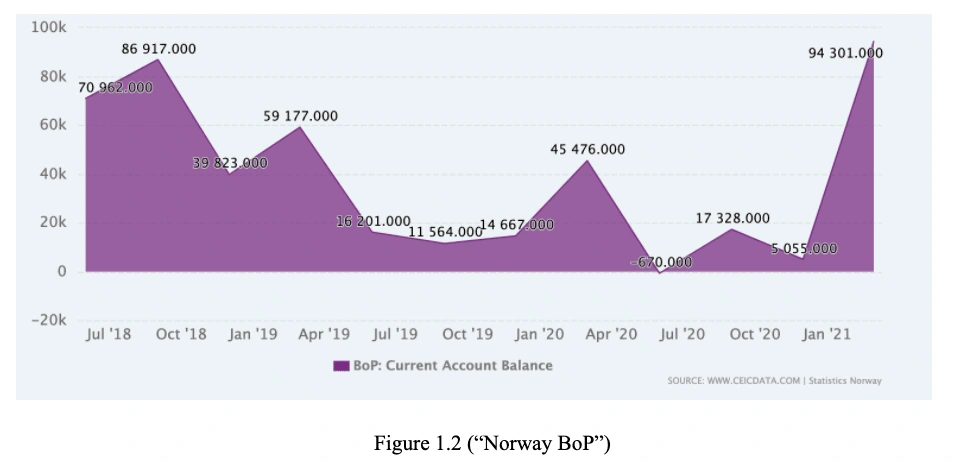
Micro Fundamentals
Industry Organization
Norway’s consumer market is small by European standards and still appears attractive to foreign suppliers. Norwegian retail trade takes place in the commercial centres such as in Oslo, Bergen, Trondheim, and Stavanger. Retailers, especially groceries, aim to expand their operations in order to gain more negotiating power at the expense of producers and wholesalers (“The Distribution”). Because of Norway’s small domestic market, its retailers are small compared to other Scandinavian countries and for that reason, they are not very active internationally. Furthermore, price levels in Norway are very high. For example, groceries cost 50% more than the EU average. Prices of alcohol and tobacco are even higher than regular groceries (“The Distribution”).
Additionally, the Norwegian distribution system is characterized by a small number of intermediaries and sensible margins (“The Distribution”). The system allows for distribution chains to dominate the market such as wholesalers like NorgesGruppen has already strengthened its market position. In 2018, Norgesgruppen was known as the leading grocery retailer in Norway because it reached a market share of 43.2% based on its sales (“The Distribution”). Moreover, Norway has established some antitrust policies that help protect competition between entities. For instance, in 2001, Norway, Iceland, and Denmark signed a cooperation agreement which helps protect the exchange of confidential information between the competition authorities (“Competition Law”). This agreement gives the competition parties or authorities greater opportunities to cooperate on certain matters. The Norwegian competition act restricts collaboration and influence on prices, mark-ups, discounts, and tenders (“Competition Law”). The act also restricts the use of intentional influence or illegal means to achieve market sharing (“Competition Law”).
Furthermore, for the past 10 years, the Norwegian grocery retail market has been characterized by chain formation and centralization (Olsen). When competition is present within a local community in Norway, grocery retail prices would be based on the marginal costs and demand controls. A systematic structure-price relationship would not exist in those situations of competition. In Table I, there are descriptive statistics showing the growth of the Norwegian grocery retail market for the period 2011-2016 (Olsen). The table includes the total revenues of the market. It can be understood from the table that the total revenues in the grocery retail market has increased over 50% during the last decade, reaching almost 70 billion NOK in 2016 (Olsen).
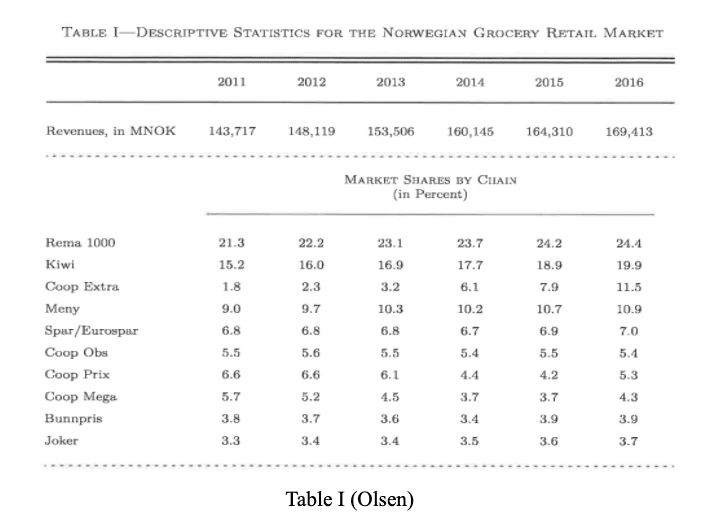
However, in Table II, there are a number of stores listed in the Norwegian grocery retail market based on grouping and geographical area (Olsen). It can be seen that the total number of stores have declined over time, implying that average revenue per store increased. This revenue growth could be from the effective improvements and the restructuring measures that were implemented by the major players in the market (Olsen). Moreover, according to Gullstrand and Jorgensen, the reason for the decline in stores can be explained by distribution costs and scale economies, allowing only the largest retailers and chains to be successful in remote areas with low population density. Either way, Oslo is the only city that is known to have increases in the number of stores during the period (Olsen).
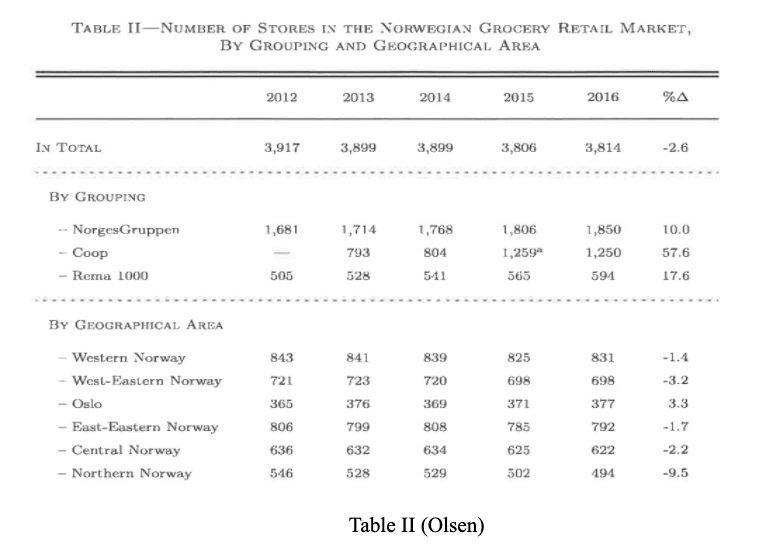
Regulatory System
The financial system in Norway provides consumers and businesses with borrowing and saving opportunities, payment services, and risk management (“Norway's Financial System”). The financial system allows businesses to borrow money so that they can finance investments in property, equipment, development, and production. This way businesses can make their payment obligations on time during unprofitable periods (“Norway's Financial System”). The financial system supports businesses by using savings to invest in profitable investment projects and helps promote economic stability. Central and local governments can also borrow money to invest or cover expenditures during an economic downturn. Moreover, businesses have the opportunity to seek insurance against various economic risks associated with their activities. For example, if there were risks associated with future prices of both intermediate goods and final products or exchange rate risks or risk of a change in interest rates, all of which can be protected by the insurance (“Norway's Financial System”). Furthermore, the financial system is primarily regulated through legislation. Authorities must issue a license so that they can establish a financial institution and perform specific services within the financial system.
Financial System
Structure and Central Bank
Norges Bank is the central bank of Norway and has the sole right to issue banknotes and coins. Banks hold accounts at the central bank and use them to settle interbank payments. Norges Bank serves as an advisory and executive body for monetary policy, enabling it to set interest rates on bank’s deposits in Norges Bank (“Norway's Financial System”). When this rate is established, it forms the basis for the interest rate level in Norway. Furthermore, Norges Bank has supervisory and regulatory responsibilities, allowing it to manage the country’s foreign exchange reserves and the government pension fund global (“Norway's Financial System”). Moreover, the Norwegian authorities cooperate with other home state authorities about the supervision and regulation of foreign banks with operations in Norway.
Furthermore, there are two equity markets in Norway known as Oslo exchange market and Oslo Axess (“Capital Markets”). The Oslo exchange market is the only regulated market for security trading. When companies do not meet the requirements to take part in the Oslo exchange market, they use another licensed and regulated market called Oslo Axess (“Capital Markets”). Additionally, there are some common types of derivatives in Norway including, options, futures, swaps, forward rate agreements, and other contracts relating to securities, currencies, interest rates or yields, commodity derivatives, and credit derivatives (“Capital Markets”).
Moreover, the Norwegian Securities Trading Act regulates short selling and certain aspects of credit default swaps (Wilhelmsen). Market participants are only allowed to short sell financial instruments if timely delivery is ensured on the agreement date. Also, if an issuer decides to sell its shares by issuing independent subscription rights, these rights need to be registered in the Norwegian Central Securities Depository (Wilhelmsen).
Major Stock Markets
The Oslo Stock Exchange organizes the daily trading of certain equity and index derivatives (Wilhelmsen). The structure of the market for those certain derivatives are divided into index futures, index options, share forwards and futures, and share or equity options. The OBX Index and the OBX Oil Service Index are the stock markets index (Wilhelmsen). They serve as the underlying instruments for index futures and index options. The OBX lists 25 most liquid companies and most traded stocks on the Oslo stock exchange in Norway (Wilhelmsen).
Opportunities to Raise Money Locally
There are some opportunities to raise money from banks and investment companies. Grocery stores like Kwik-E-Mart can receive funding locally. For instance, Kolonial, one of Norway’s leading online grocery store has received funding of about NOK 2.2 billion from Kinnevik, Softbank, and Prosus (Tucker). These newly raised funds are going to be used to fund plans that will help expand Kolonial to more markets overseas, beginning with Finland (Tucker). As Kolonial is expanding its branches to other countries and becoming a global company, it is changing its brand name so it can have a more precious meaning that everyone globally can understand (Tucker).
Opportunities for Foreign Direct Investment
Major Players
Norway has registered to have a positive inflow trend since 2018 with USD 4.3 billion (“Norway: Foreign”). This positive growth was finally happening after three years of negative FDI inflows between 2015-2017 in Norway. Norway’s inward stock was listed at USD 167.5 billion in 2019. The country continues to be a large investor abroad with outward flows of USD 8 billion and outward stock of USD 218.5 billion during 2019. Furthermore, the Netherlands and Sweden rank as top two investors in Norway, accounting for 30% of inflows (“Norway: Foreign”). The Norwegian economy is rich in resources like petroleum and gas. When prices of hydrocarbons decrease, investments on Norwegian oil companies decrease as well. Norway has signed bilateral investment treaties with several countries (“Norway: Foreign”).
Major players within the grocery industry in Norway are NorgesGruppen, Coop, and ReitanGruppen (Olsen). NorgesGruppen is the market leader within the grocery retail market in Norway. It has 1,850 grocery stores across the country. Other than its grocery retail activities, NorgesGruppen has expanded its specializations and now does wholesaling and real estate business in Norway (Olsen). Secondly, Coop has the next largest grocery chain within the Norwegian grocery retail market with 1,250 stores as of 2016. Coop is owned by consumers through regional cooperatives (Olsen). Coop has no ownership in the stores, but it is responsible for establishing different concepts for the stores, marketing, supply chain, and chain management. Thirdly, ReitanGruppen is the only group within the Norwegian grocery retail market that operates with a single concept, Rema 1000. All Rema 1000 stores operate as franchises within Norway (Olsen). Each store operates independently based on its own conditions set by the chain management. ReitanGruppen has 594 stores and a market share of over 24% (Olsen).
Restrictions
Some disadvantages of FDI in Norway include the idea that Norway’s economy is not very diversified and instead its economy is heavily dependent on the price of oil (“Norway: Foreign”). Also, certain regions within Norway are very isolated and rural, making expenditures in areas of transportation, logistics, and telecommunications to be very high and costly. Some restrictions include how Norway does not offer high tax benefits to investors whether they are foreign or Norwegian (“Norway: Foreign”). However, there are some benefits like lower social security contributions, lower tax rates, and other additional deductions for individuals or entities that have invested in less populated areas of northern Norway. Most importantly, certain existing rulings, regulations, standards, and practices would slightly benefit and favour Norwegian, Scandinavian, and European Economic Zone investors (“Norway: Foreign”). Other restrictions exist on foreign ownership and use of natural resources. Norway restricts FDI from the use of waterfalls, rights for power supply and mines and acquisition of land, real estate and leases in the long term. Norway restricts the purchase of more than 10% of the share of capital from a Norwegian financial institution (“Norway: Foreign”).
Different ways of FDI
The best opportunities for investments are mainly contributed to sectors involving consumer goods, information and communication technologies, construction and services for business, food processing, and oil and gas (“Norway: Foreign”). Sectors where investment opportunities are fewer are postal services, railways, domestic production, and retail sale of alcohol (“Norway: Foreign”). There are about 5,500 foreign-owned companies in Norway and over 650 American companies employ over 45,000 people in Norway (“2019 Investment Climate”).
Summary
Norway is a Scandinavian country in Northern Europe, sharing its borders with the Barents, Norwegian, North, and Skagerrak Seas. The Norwegian government had negotiated a trade agreement in the past with European Union so that Norwegian companies could have access to European markets and that they can trade with one another. During the COVID-19 pandemic, Norwegians had changed their purchasing habits, causing a shift to their preferences and consumption patterns in a way that they started to spend less on services and more on certain retail goods. Moreover, Norges Bank is the central bank of Norway and is responsible for the issuance of money and other bank notes. During the COVID-19 pandemic, the country was in need of preparing food packages for people who were unemployed. The Food Banks Norway was established to help distribute the food from producers to wholesalers and to non-profit organizations for final distribution. Norway has a small domestic market that imposes restrictions on foreign investors in terms of alcohol business. Sweden and the Netherlands are great foreign investors for Norway. Three grocery retail markets in Norway are NorgesGruppen, Coop, and ReitanGruppen. They help determine the grocery business within Norway and certain restrictions are applied for foreigners if they want to start a business in Norway.
Works Cited
“2019 Investment Climate Statements: Norway.” U.S. Department of State, www.state.gov/reports/2019-investment-climate-statements/norway/.
“Capital Markets and Structured Investments.” DLA Piper Intelligence, www.dlapiperintelligence.com/investmentrules/countries/index.html?p=capital-markets&t=entering-into-derivatives-contracts&s=notable-risks-issues&c=NO.
“Competition Law and Policy in Norway.” Organisation for Economic Co-Operation and Development, www.oecd.org/norway/34836352.pdf.
“Demographic Panorama - Norway.” Market: Europe, vol. 15, no. 12, Dec. 2004, p. 7. EBSCOhost, search-ebscohost-com.ezproxy.csusm.edu/login.aspx?direct=true&db=buh&AN=15379208&site=bsi-live.
“FocusEconomics.” “Norway Interest Rate - Norway Economy Forecast & Outlook.” FocusEconomics, Economic Forecasts from the World's Leading Economists, www.focus-economics.com/country-indicator/norway/interest-rate.
“Government & Politics.” Life in Norway, 31 Jan. 2018, www.lifeinnorway.net/about-norway/government/.
“Key Policy Insights: OECD Economic Surveys: Norway 2019: OECD ILibrary.” Key Policy Insights, OECD Economic Surveys: Norway 2019, OECD ILibrary, www.oecd-ilibrary.org/sites/a3add2b2-en/index.html?itemId=/content/component/a3add2b2-en.
“Norway BoP: Current Account Balance.” CEIC, www.ceicdata.com/en/norway/bpm6-balance-of-payment/bop-current-account-balance.
“Norway Inflation Rate.” Norway Inflation Rate, 1950-2021 Data, 2022-2023 Forecast, Calendar, Historical, tradingeconomics.com/norway/inflation-cpi.
“Norway Population 2021.”(n.d.). Retrieved August 06, 2021, from https://worldpopulationreview.com/countries/norway-population
“Norway: Foreign Investment.” Foreign Investment in Norway - Santandertrade.com, Aug. 2021, santandertrade.com/en/portal/establish-overseas/norway/foreign-investment?url_de_la_page=/en/portal/establish-overseas/norway/foreign-investment&&actualiser_id_banque=oui&id_banque=0&memoriser_choix=memoriser.
“Norway's Financial System.” Norges Bank, 2018, www.norges-bank.no/contentassets/d8039ff2c8a9438c9400132c46c241e1/nfs_2018.pdf?v=09/24/2018121310&ft=.pdf.
“Short Overview of the Labour Market.” European Commission, May 2021, ec.europa.eu/eures/main.jsp?catId=2600&countryId=NO&acro=lmi&lang=en®ionId&nuts2Code= &nuts3Code=®ionName.
“Strong Increase in Retail Sales in April.” Ssb.no, 27 May 2020, www.ssb.no/en/varehandel-og-tjenesteyting/artikler-og-publikasjoner/strong-increase-in-retail-sales-in-april.
“Svein Gjedrem: Monetary policy in Norway.” The Conduct of Monetary Policy in Open Economies. https://www.bis.org/review/r001115c.pdf
“The Distribution Network in Norway.” Nordea Trade, Aug. 2021, www.nordeatrade.com/se/explore-new-market/norway/distribution.
“The Political Framework of Norway.” The Political Framework of Norway - Economic and Political Overview - Nordea Trade Portal, www.nordeatrade.com/no/explore-new-market/norway/political-context.
Jansson, Johannes. “Facts about Norway.” Nordic Cooperation, www.norden.org/en/information/facts-about-norway.
Media, Triami. “Key Policy Rate, Interest Rate Central Bank of Norway.” Key Policy Rate – Current and Historic Interest Rates Central Bank of Norway, www.global-rates.com/en/interest-rates/central-banks/central-bank-norway/kpr-interest-rate.aspx
Norgaard, Elisabeth. “The Norwegian Balance of Payments.” Statistics Norway, www.ssb.no/a/histstat/rapp/rapp_199823.pdf.
Olsen, Damian Sanchez, and Martin Sanchez Olsen. “Bad Neighbors? Local Price Competition in the Norwegian Grocery Retail Market.” NHH NORGES HANDELSHØYSKOLE, 2017, www.nhh.no/contentassets/ef25235953bd4af58671fa1bd5771495/olsen_olsen.pdf.
Tucker, Charlotte. “Norway-Based Kolonial, a Leading Online Grocery Store, Lands €223 Million and Re-Brands to Oda: EU-Startups.” EU Startups, 8 Apr. 2021, www.eu-startups.com/2021/04/norway-based-kolonial-a-leading-online-grocery-store-lands-e223-million-and-re-brands-to-oda/.
Wilhelmsen, Linn M A, and Per Morten Christiansen. “Q&A: Equity Derivatives in Norway.” Lexology, Advokatfirmaet Selmer AS, 20 May 2020, www.lexology.com/library/detail.aspx?g=d393bc13-3798-426d-941e-bcbb5a75a94b.
Winslow, Evan. “The Strategy to Support Norway Offers a Ray of Hope.” Borgen Magazine, 16 July 2021, www.borgenmagazine.com/strategy-to-support-norway/.
Like this project
Posted Dec 18, 2021
The research, as a fictional Kwik-E-Mart owner, evaluates Norway's international markets to recommend whether the business should expand there.
Likes
0
Views
45



